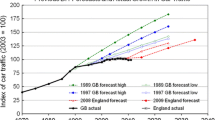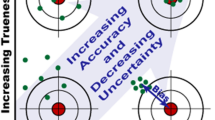“All [traffic forecasting] models are wrong; by how much determines their usefulness.” George Box.
“The future isn’t what it used to be.” Yogi Berra.
“Pay no attention to that man behind the curtain!” The Wizard of Oz.
Abstract
This study reviews the 50-year history of travel demand forecasting models, concentrating on their accuracy and relevance for public decision-making. Only a few studies of model accuracy have been performed, but they find that the likely inaccuracy in the 20-year forecast of major road projects is ±30 % at minimum, with some estimates as high as ±40–50 % over even shorter time horizons. There is a significant tendency to over-estimate traffic and underestimate costs, particularly for toll roads. Forecasts of transit costs and ridership are even more uncertain and also significantly optimistic. The greatest knowledge gap in US travel demand modeling is the unknown accuracy of US urban road traffic forecasts. Modeling weaknesses leading to these problems (non-behavioral content, inaccuracy of inputs and key assumptions, policy insensitivity, and excessive complexity) are identified. In addition, the institutional and political environments that encourage optimism bias and low risk assessment in forecasts are also reviewed. Major institutional factors, particularly low local funding matches and competitive grants, confound scenario modeling efforts and dampen the hope that technical modeling improvements alone can improve forecasting accuracy. The fundamental problems are not technical but institutional: high non-local funding shares for large projects warp local perceptions of project benefit versus costs, leading to both input errors and political pressure to fund projects. To deal with these issues, the paper outlines two different approaches. The first, termed ‘hubris’, proposes a multi-decade effort to substantially improve model forecasting accuracy over time by monitoring performance and improving data, methods and understanding of travel, but also by deliberately modifying the institutional arrangements that lead to optimism bias. The second, termed ‘humility’, proposes to openly quantify and recognize the inherent uncertainty in travel demand forecasts and deliberately reduce their influence on project decision-making. However to be successful either approach would require monitoring and reporting accuracy, standards for modeling and forecasting, greater model transparency, educational initiatives, coordinated research, strengthened ethics and reduction of non-local funding ratios so that localities have more at stake.

Similar content being viewed by others
References
Alonso, W.: Predicting best with imperfect data. J. Am. Inst. Plan. 34(4), 248–255 (1968)
Auld, J., Zhang, L.: Inter-personal interactions and constraints in travel behavior within households. Transportation 40–4, 751–754 (2013)
Altshuler, A., Luberoff, D.: Mega-Projects: The Changing Politics of Urban Public Investment. Brookings Institute, Washington (2003)
Australian Government: Dept of Infrastructure and Transport. Public Consultation: Patronage Forecasting for PPP/Toll Roads. http://www.infrastructure.gov.au/infrastructure/public_consultations/patronageforecasting.aspx (2012). Accessed June 19, 2013
Bain, R.: Error and optimism bias in toll road traffic forecasts. Transportation, 36 (5), p. 469–482. http://www.robbain.com/Bain_Transportation_2009.pdf (2009)
Bain, R.: Big numbers win prizes. Project Finance International. www.pfie.com (2009)
Bain R.: On the reasonableness of traffic forecasts, Traffic Engineering and Control. www.tecmagazine.com (2011)
Bain R.: Toll Roads Big Trouble Down Under. Infrastructure Journal (2013)
Bartholomew, K.: Land use-transportation scenario planning: promise, and reality. Transportation 34(4), 397–412 (2007)
Ran, B., Tavner, P.J., et al.: Perspectives on future transportation research: impact of intelligent transportation system technologies on next-generation transportation modeling. J. Intell Transp Syst: Technol, Plan Oper 16(4), 226–242 (2012)
Boyce, D.E., Williams, H.C.W.L.: Urban travel forecasting in the USA and UK. In: Reggiani, A., Schintler, L. (eds.) Methods and Models in Transport and Telecommunications: Cross Atlantic Perspectives, pp. 25–44. Springer, Berlin (2005)
Boyce, D.C., Williams, H.C.W.L.: Forecasting Urban Travel—Past, Present, and Future. Edward Elgar Publishing Ltd., Cheltenham, UK (Forthcoming,2013)
Britton, E et al.: The inflation report projections—understanding the fan chart. Bank of England Conjunctural Assessment and Projections Division, Inflation Report, (1999)
Cantarelli, C et al.: Cost overruns in large-scale transportation infrastructure projects: explanations and their theoretical embeddedness. Transportation 10:1, p 5–18, Mendeley Publications (2010)
Chatterjee, A et al. Improving Transportation Data for Mobile Source Emissions Estimates, NCHRP Report 394, Transportation Research Board, Washington, DC. www.trb.org (1997)
Chow, J. Y. J., et al. Is transport modeling education too multi-disciplinary? a manifesto on the search for its evolving identity. Resource paper presented at the conference of the International Association for Travel Behavior Research, Toronto CA, (2012)
de Jong, G., Daly, A., Pieters, M., Miller, S., Plasmeijer, R., Hofman, F.: Uncertainty in traffic forecasts: literature review and new results for The Netherlands. Transportation 34, 375–395 (2007)
Deutsch, K., Goulias, K.G.: Decision makers and socializers, social networks, and the role of individuals as participants. Transportation 40(4), 755–772 (2013)
Department for Transport (United Kingdom): Traffic Forecast Errors Highlighted, Contract Journal (1988)
Department for Transport (United Kingdom). National Road Traffic Forecasts (Great Britain), 1997: Treatment of Uncertainty. Working Paper #5 (1998)
Department for Transport (United Kingdom): Transportation Analysis Guidance: Treatment of uncertainty in model forecasting. Section 3.15.5. http://www.dft.gov.uk/webtag/index.php (2013)
Donnelly, R. et al. Advanced Practices in Travel Forecasting: A Synthesis of Highway Practice. National Cooperative Highway Research Program Synthesis 406, Transportation Research Board. www.trb.org (2010)
European Court of Auditors, Are EU cohesion policy funds well spent on roads? Special Report No. 5, Luxembourg, Luxembourg. http://eca.europa.eu (2013)
Federal Highway Administration: Interim guidance on the application of travel and land use forecasting in NEPA. USDOT. www.fhwa.dot.gov (2010)
Federal Transit Administration: The predicted and actual impacts of New Starts projects: capital cost and ridership. Federal Transit Administration, Washington DC (2008)
Federal Transit Administration: Travel Forecasting for New Starts Proposals. Workshop PowerPoint presentations, Tampa Florida. http://www.fta.dot.gov/12304_9547.html (2009)
Federal Transit Administration. Proposed New Starts Policy Guidance. US Dept of Transportation. http://www.fta.dot.gov/documents/NewStartsPolicyGuidance.pdf (2013)
Florida Department of Transportation. Generalized annual average daily volumes for Florida’s urbanized areas, Systems Planning Office, FDOT, Tallahassee, FL 32399-0450, October 4, (2010)
Flyvbjerg, B. et al. Megaprojects and risk: an anatomy of ambition. Cambridge University Press (2003)
Flyvbjerg, B., et al.: Inaccuracy in traffic forecasts. Transport Reviews 26(1), 1–24 (2006)
Flyvbjerg, B.: Survival of the un-fittest: why the worst infrastructure gets built and what we can do about it. Oxford Rev Econ Policy 25(3), 344–367 (2009)
Flyvbjerg, B. [The] majority of forecasters are fools or liars. BT Centre for Major Programme Management, Saïd Business School, University of Oxford. www.sbs.ox.ac.uk (2013)
Forster, A.: Punish consultants for faulty forecasts, says project expert. TransportXtra, Dec. 21. www.transportxtra.com (2012)
Forster, A.: Client data often to blame for forecasting errors, say planners. TransprtXtra, January 11. www.transportxtra.com (2013)
Hartgen, DT et al.: Are they ready? Mega-region growth and transportation investment. A report to the Urban Land Institute, Washington DC, March 7. www.hartgengroup.net (2008)
Highway Capacity Manual: Transportation Research Board. www.trb.org (2010)
International Association for Travel Behavior Research (IATBR). www.iatbr.weebly.com (2013)
Jaggi, B., Axhausen, K.: Comparison of approaches on the computation of travel time losses on high capacity, paper submitted to the Transportation Research board, 2014 Annual Meeting, version of June 16 (2013)
Johnston, D.: Traffic Forecasting for Australian Toll Roads. Comments to the Australian Road Agency. http://www.infrastructure.gov.au/infrastructure/public_consultations/patronage_forecasting_submissions/index.aspx (2012)
Jones, P.: The role of an evolving paradigm in shaping international transport research and policy agendas over the last 50 years. University of Oxford, UK, June 25 (2012)
Lemp, J. D., Kockelman, K. M.: Understanding and accommodating risk and uncertainty in toll road projects: a review of the literature. Transportation Research Record 2132, TRB, Washibngton DC, p. 106–12. www.trb.org (2009)
Li, Z., Hensher, D.: Toll roads in Australia: an overview of characteristics and accuracy of demand forecasts. Transp Rev 30(5), 541–569 (2010)
Mackie, P., Preston, J.: Twenty-one sources of error and bias in transport project appraisal, Transport Policy, 5:1, p. 1–7 (1998)
Naess, P. Flyvbjerg, B., Buhl, S.: Do road planners produce more ‘honest numbers’ than rail planners? an analysis of accuracy in road-traffic forecasts in cities versus peripheral regions. Transport Reviews, 26(5), pp. 537–555 (2006)
National Association of Municipal Analysts (NFMA). Recommended Best Practices in Disclosure for Toll Road Financings. http://www.nfma.org/disclosure/rbp_toll_road.pdf (2005)
National Cooperative Highway Research Program, Driving forces influencing future freight flows, NCHRP Web Document 195. www.trb.org (2010)
National Cooperative Highway Research Program. Estimating toll road demand and revenue, Synthesis 364, Washington DC: Transportation Research. www.trb.org (2006)
O’Toole, R. Roadmap to gridlock: the failure of long-range metropolitan transportation planning. Cato Institute, Policy Analysis Paper 617. www.cato.org (2008)
Pas, E.: Is travel demand analysis and modelling in the doldrums? In: Jones, P.M. (ed.) Developments in Dynamic and Activity-Based Approaches to Travel Analysis, pp. 3–27. Oxford Studies in Transport, Aldershot (1990)
Pickrell, D. H.: Urban rail transit projects: forecast versus actual ridership and costs. Final Report, Urban Mass Transit Administration, Volpe Center, Boston MA (1989)
Pickrell, D.H.: A desire named streetcar: fantasy and fact in rail corridor planning. J. Am. Plan. Assoc. 58(2), 158–176 (1992)
Polak, John.: New challenges in city transport modeling. Address to Modeling World, reported in Local Transport Today (2013)
Polzin, S. Prescription for the future. Private correspondence with the author (2013)
Pratt, RH. Traveler response to transportation systems changes. Report 95, National Transit Cooperative research Program, Transportation Research Board. Washington DC. www.trb.org (2013)
Shuldiner A and Shuldiner P. The measure of all things: reflections on changing conceptions of the individual In travel demand modeling. Transportation, Vol. 40.6 (2013)
Spielberg, F.: Metropolitan travel forecasting, Special Report 288, Transportation Research Board. www.trb.org (2007)
Stopher, P.R., Meyburg, A.H. (eds.): Second International Conference on Behavioural Travel Demand: Lexington Books. Lexington, Massachusetts (1976)
Strategic Highway Research Program II, Travel time reliability 2030: a reliability project brief. Transportation Research Board. www.trb.org (2013)
Strategic Highway Research Program II, Partnership to Develop an Integrated, Advanced Travel Demand Model and a Fine-grained, Time-Sensitive Network. Project C10(A and B). http://apps.trb.org/cmsfeed/trbnetprojectdisplay.asp?projectid=2829 (2013)
Supreme Court of the State of New York, New York County, Part 45, Syncora Guarantee Inc v. Alinda Capital Partners LLC et. al. Docket # 651258/2012, Motion Seq. No. 002. http://www.texasturf.org/2012-06-01-03-09-30/latest-news/public-private-partnerships/401-fraud-lawsuit-against-toll-giant-macquarie (2013)
Talvitie, A.: Things planners believe in, and things they deny. Transportation 24(1), 1–31 (1997)
Transportation Research Board. Issues in Behavioural Demand Modeling and the Evaluation of Travel Time. Special Report 149, Transportation Research Board, Washington, D.C. www.trb.org (1973)
Travel Model Improvement Program. Travel model reasonableness checking manual, Second Edition, Federal Highway Administration. www.fhwa.dot.gov (2010)
van Vuren T. Be humble. Keynote address to German transport officials. As reported in Local Transport Today. www.transxtera.com (2013)
Vassallo, J. M.:Why traffic forecasts in PPP contracts are often overestimated? EIB University Research Sponsorship Program, EIB, Luxembourg. (Madrid: EIB, Polytechnic University of Madrid, Spain) (2007)
Wachs, M.: When planners lie with numbers. J. Am. Plan. Assoc. 55, 476–479 (1989)
Wachs, M.: Ethics and advocacy in forecasting for public policy. Bus Prof Ethics J 9, 1–2 (1990)
Wachs, M. Turning cities inside out: transportation and the resurgence of downtowns in North America. Transportation 40.6, (draft of 6-18/13) (2013)
Welde, M., Odeck, J.: Do planners get it right? the accuracy of travel demand forecasting in Norway. Eur. J. Transp. Infrastructure Res. Issue 11(1), 80–95 (2011)
World Bank. Successes and failures of PPP projects (The World Bank, Europe and Central Asia Region) (2008)
Worsley, J. Multiple ways to model transport’s impact on the wider economy. Remarks to Modeling World. As reported in Local Transport Today, (2013)
Zhao, Y., Kockelman, K.M.: The propagation of uncertainty through travel demand models: an exploratory analysis. Annals Reg Sci 36(1), 145–163 (2002)
Acknowledgments
The author is indebted to many colleagues, but particularly to Robert Bain, Ken Cervenka, David Hyder, Ram Pendyala, Steven Polzin, Guy Rousseau, Howard Slavin and Martin Richards for comments relating to this paper. The author of course remains wholly responsible for the views expressed herein.
Author information
Authors and Affiliations
Corresponding author
Rights and permissions
About this article
Cite this article
Hartgen, D.T. Hubris or humility? Accuracy issues for the next 50 years of travel demand modeling. Transportation 40, 1133–1157 (2013). https://doi.org/10.1007/s11116-013-9497-y
Published:
Issue Date:
DOI: https://doi.org/10.1007/s11116-013-9497-y




